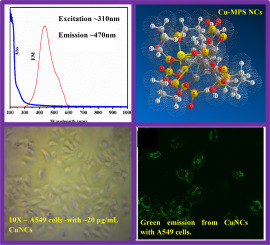Journal of Photochemistry and Photobiology B: Biology ( IF 5.4 ) Pub Date : 2020-03-05 , DOI: 10.1016/j.jphotobiol.2020.111845 Murugan Ramadurai , Ganapathy Rajendran , Thangapandian Sathya Bama , Pandurangan Prabhu , Krishnan Kathiravan

|
We report, the one-pot synthesis of water-soluble and biocompatible 3-mercaptopropylsulfonate (MPS) protected novel copper nanoclusters (CuNCs). Interestingly, the TEM image of MPS protected CuNCs exhibits an ultrasmall nanoclusters of particle size <2 nm, similar to its Au and Ag analogue. The hydrophilic and biocompability property of thiolate protected CuNCs. i.e., MPS stabilized CuNCs and its luminescent nature gave rise to maximum quantum yield of 1.5%. Further, as achieved CuNCs was investigated for haemocompatibility, cell viability and fluorescent microscopic analysis with A549 lung cancer cell line. Haemolytic study was examined using human RBCs in the concentration range of 4 to 22 μg/mL for which 7.5% of haemolysis was obtained for an optimum concentration of 22 μg/mL of CuNCs. The cell viability analysis was carried out by MTT assay using A549 lung cancer cells for the minimum (10 μg/mL) and maximum (45 μg/mL) concentration of CuNCs which reports 93.1% and 38.2% cell viability respectively. The inverted light microscopic images from the control and CuNCs treated (20 μg/mL) cells exhibited an excellent biocompatibility with a normal morphology. Upon increasing the concentration of CuNCs upto 45 μg/mL, the cell viability trends to decrease and the cell morphology also denature gradually. Further, the bio-imaging application of CuNCs was analyzed with A549 lung cancer cells. The efficient imaging with CuNCs treated (20 μg/mL) A549 cells resulted in a green colour emission using FITC filter (460- 490 nm). Thereby the obtained results confirm the applicability of CuNCs for the biomedical and cancer diagnosis applications.
中文翻译:

生物相容性硫醇盐保护的铜纳米簇可有效成像肺癌细胞
我们报告,一锅合成的水溶性和生物相容性3-巯基丙基磺酸盐(MPS)保护新型铜纳米团簇(CuNCs)。有趣的是,受MPS保护的CuNCs的TEM图像显示了粒径小于2 nm的超小纳米簇,类似于其Au和Ag类似物。硫醇盐保护的CuNCs的亲水性和生物相容性。也就是说,MPS稳定的CuNCs及其发光性质导致最大量子产率为1.5%。此外,对已获得的CuNCs进行了A549肺癌细胞系的血液相容性,细胞活力和荧光显微镜分析。使用浓度范围为4至22μg/ mL的人类RBC进行了溶血研究,对于CuNCs的最佳浓度,获得了7.5%的溶血率。细胞活力分析是通过A549肺癌细胞通过MTT分析进行的,其中CuNCs的最低(10μg/ mL)和最大(45μg/ mL)浓度分别报告了93.1%和38.2%的细胞活力。来自对照和CuNCs处理的细胞(20μg/ mL)的倒置光学显微镜图像显示了具有正常形态的出色生物相容性。将CuNCs的浓度增加至45μg/ mL时,细胞活力趋于下降,并且细胞形态也逐渐变性。此外,用A549肺癌细胞分析了CuNCs的生物成像应用。使用CuNCs处理过的(20μg/ mL)A549细胞进行有效成像,使用FITC滤光片(460-490 nm)发出绿色光。因此,所获得的结果证实了CuNCs在生物医学和癌症诊断应用中的适用性。



























 京公网安备 11010802027423号
京公网安备 11010802027423号